I’m currently working on a larger project of painting wildlife and plant illustrations for several information boards about local habitats. To prepare and learn more about some of the species I’m creating study pages in my sketchbook – several small studies of the species in questions, preferably from different angles, with additional notes and information, and additional color. I’ve tried to take the time for these studies because it really helps and it’s also a lot of fun, although often I just have to get the illustration done. This is what I’ve mainly been doing in the last two months, and will continue to do for a while.
Many of the species I sketched here are “not in season”, so I work mostly from photo references. This has downsides, but working with live specimen is often not possible for natural history illustration projects as there’s usually a deadline. I really like drawing on location and I miss it a bit, but as an example with flowers that bloom once a year for three weeks it’s just not possible. But since these are local species I already have a lot of plans for more research and sketching hikes next year. The project will be finished then, but I really want to see some of the local wild orchids and butterflies now, and now I know where to find them!
The interesting side effect of these detailed nature studies on each page have led to a very consistent sketchbook – I really like almost every page, which isn’t always the case with my more experimental sketchbooks and more spontaneous nature studies. I’m a big proponent of experimenting and allowing and inviting failed pages into the sketchbook, but I have to say I also enjoy leafing through this sketchbook. I miss sketching just for myself and exploring new things, but learning more about habitats and species has also been very rewarding.
I’ve been using a huge sketchbook (20x25cm), which is an absolute joy to draw in. I’ve been thinking of just this size from now on whenever I can, but I still want to use decent paper (which means most likely cotton, I’m done with painting on cellulose paper). Currently I’m using up my Hahnemühle Expression paper in this self-made sketchbook, which is a cold-pressed cotton paper that is okay, but nothing I would buy in larger quantities again.
My technique is mostly the same on each page: pencil studies of the species in question, notes (taken with pencil or fountain pen), and color and detail drawing where needed. It is really enjoyable to build up visual and background knowledge about individual species this way.
Here’s a video version of this sketchbook tour:
Sketchbook Tour Fall ’21: Detailed nature studies (video part 1)
On to the study sheets part one:
I actually encountered an Alpine newt this year while hiking, and it’s a fascinating creature to observe. They are usually very slow and tolerate cameras pointed at them. I particularly like the faint, almost invisible pattern on the side.
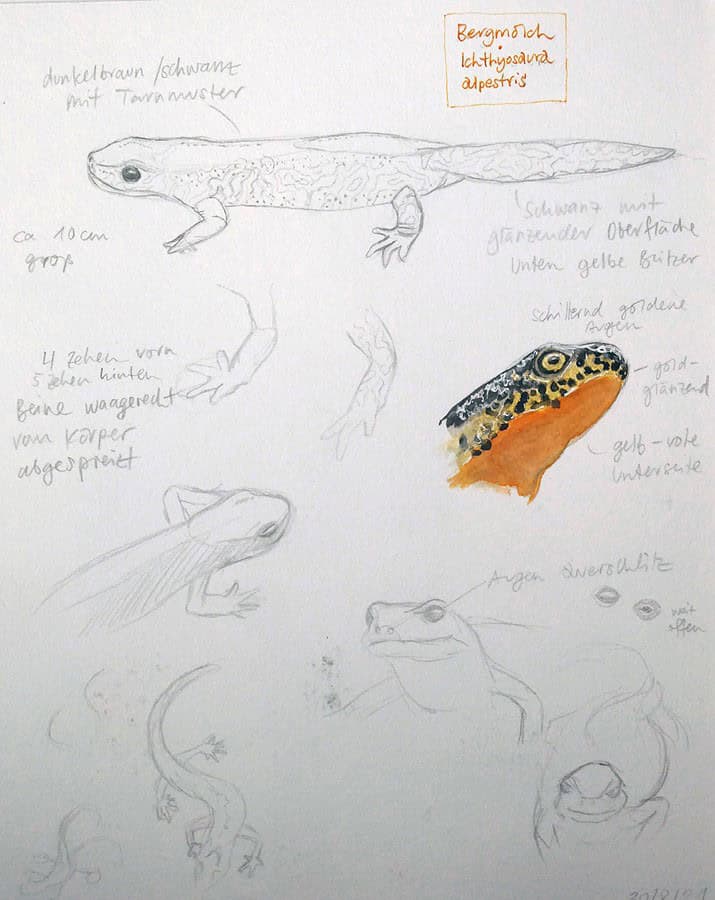
One of my favorite finch visited my balcony this year and I took the opportunity for some detailed sketches. There were two individuals, one with the familiar red face mask, and one with a duller, grey-brown plumage – a juvenile bird. They enjoyed shredding away the seeds of my cosmos flowers.
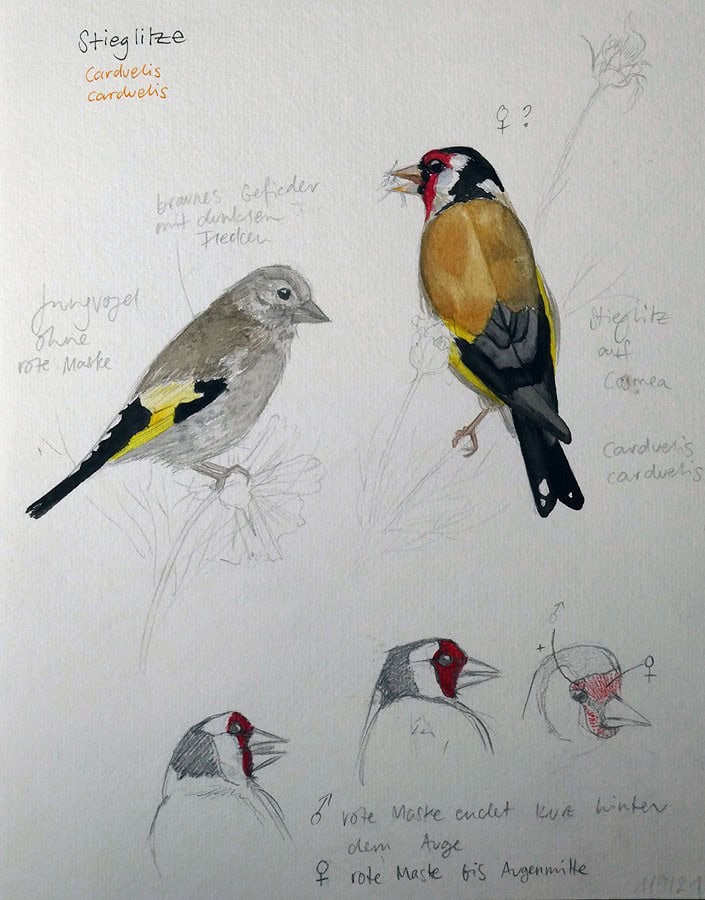
Sand lizards are always a bit shy and disappear quickly, so I’m very happy to have my own photo references. With reptiles, it’s always a challenge to get all the details and scale structure right, in these sketches I took a loose approach.
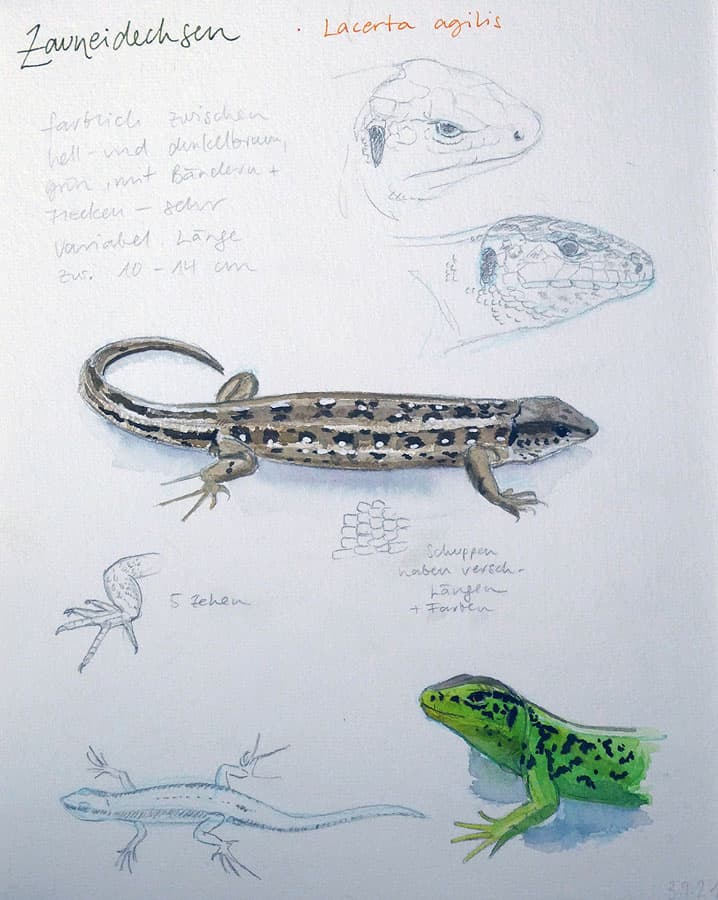
Wild orchids are one of the most fascinating and most loved flowers among naturalists, and the orchid enthusiasts that I know are almost as serious as the nerdiest birders. Many people aren’t aware that we have local wild orchids in Europe that grow in our moderate climate. These are not the tropical plants that you buy in supermarkets and put on your windowsill, although they can look a bit similar. I had a very serious orchid hunter phase in my youth (thanks to my mother who is a true expert and who probably ruined me for life with this), and my love for these unique plants has been rekindled lately. I hope to explore a lot of exciting local orchid habitats next year. The one I sketched here is a bee orchid (Ophrys apifera), one of the more spectacular species. I really had a fun time with all the details on the lip of the blossom.
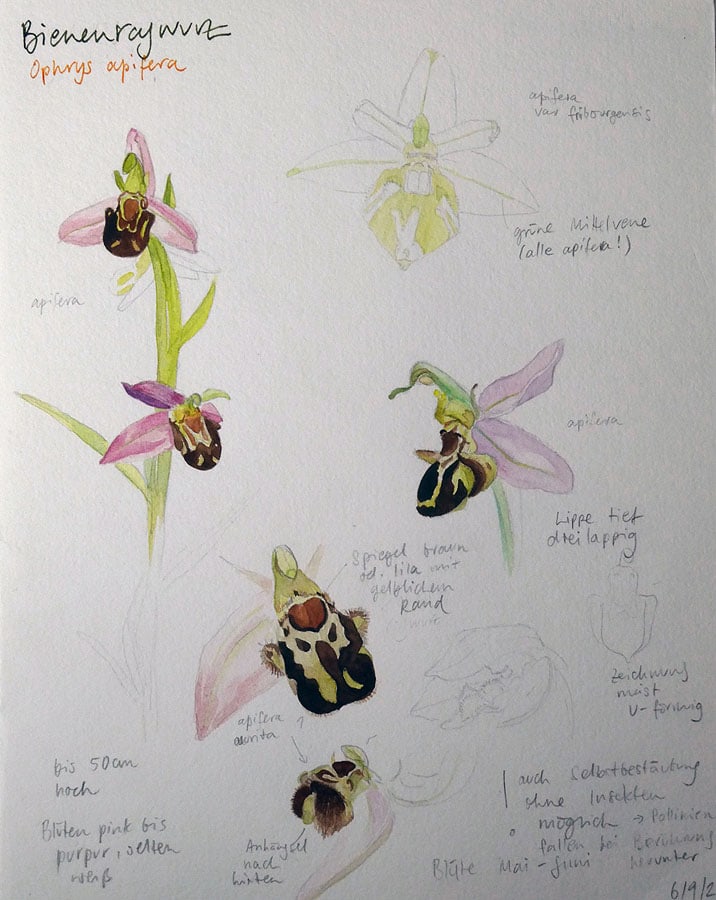
Another beautiful orchid, the late-spider orchid (Ophrys holoserica). These kind of orchids, the ophrys genus (there are more as we will see in a minute) actually mimic insects – they are evolved to look, feel and smell like a female insect of a certain species. A male insects will approach and try to copulate with the blossom, and pollinate the flower this way. This is actually a very effective technique, studies indicate this specialization works better than offering nectar to a wide variety of species. However, the names of the orchids are not always connected to the insect species they rely on – the German name for this orchid is actually “bumble-bee orchid” and it’s pollinated by a certain bee species (Eucera longicornis).
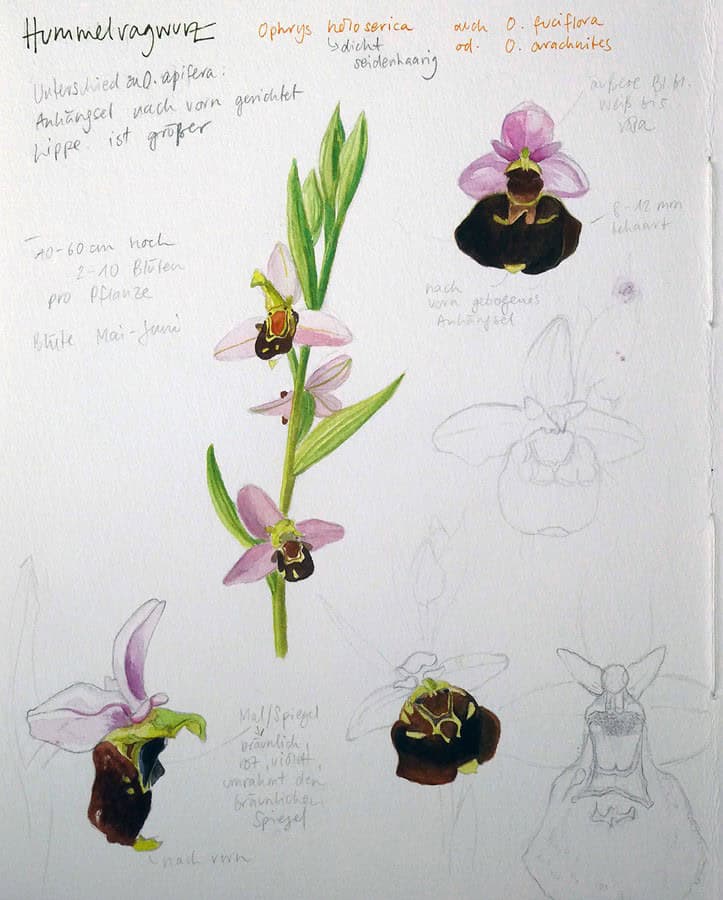
Another interesting orchid that’s really beautiful and unique is the lady’s slipper (Cypripedium calceolus). It has a bright bulgy lip that’s formed like a huge yellow slipper. I particularly loved exploring the long, twisted petals with the beautiful purple-brown color (the perfect pigment to use for this is perylene maroon!).
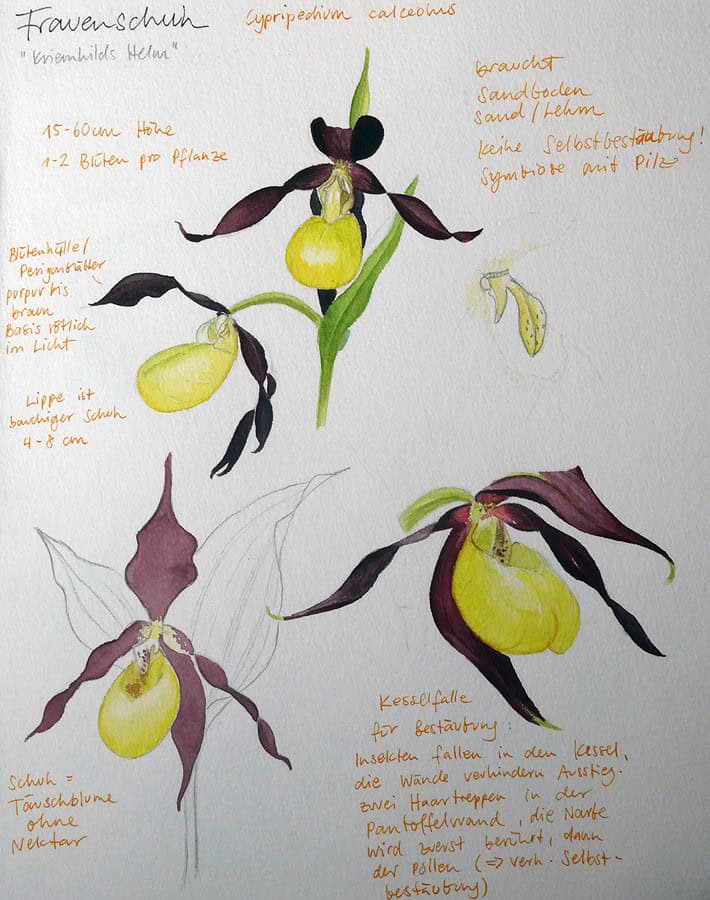
Another field that I started studying more seriously this year are meadow butterflies – these small, often blue or brown butterflies are hard to identify, and it’s a wonderful process getting them to know through sketching and photography. Most of these butterflies live in the same areas as the orchids, and I focused on four different spectacular species on this page: The sloe hairstreak (Satyrium acaciae), the pale clouded yellow (Colias hyale), green hairstreak (Callophrys rubi) and the pearly heath (Coenonympha arcania). I love all the different colors.
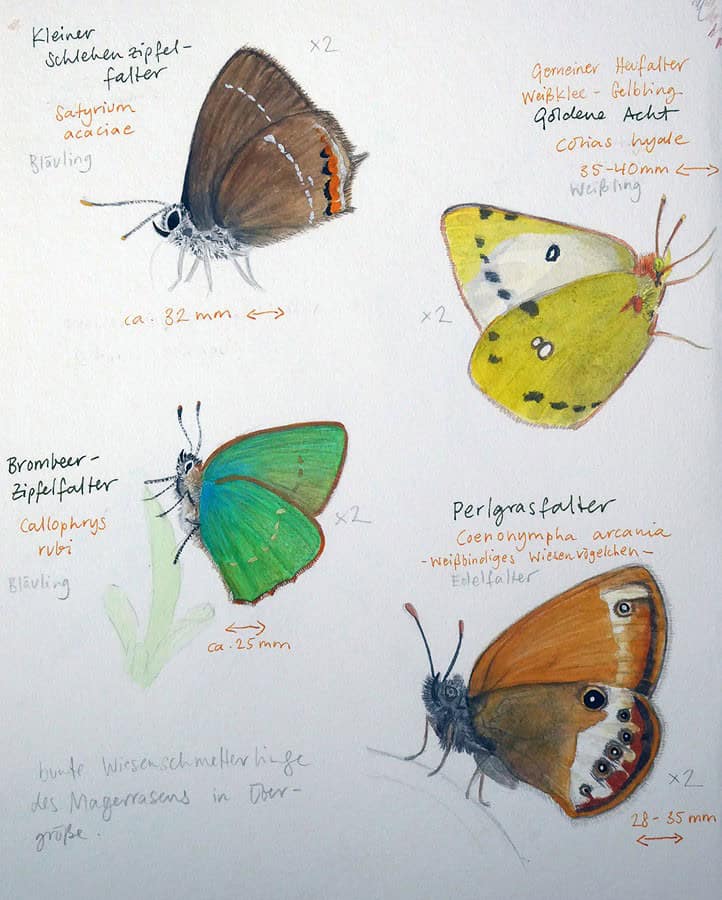
It’s time to return to the orchids, this time the military orchid (Orchis militaria), named aptly due to the sepals and petals grouped together like a helmet. This is actually a quite common and large orchid (25-50cm height). Very fun but time-consuming to draw.
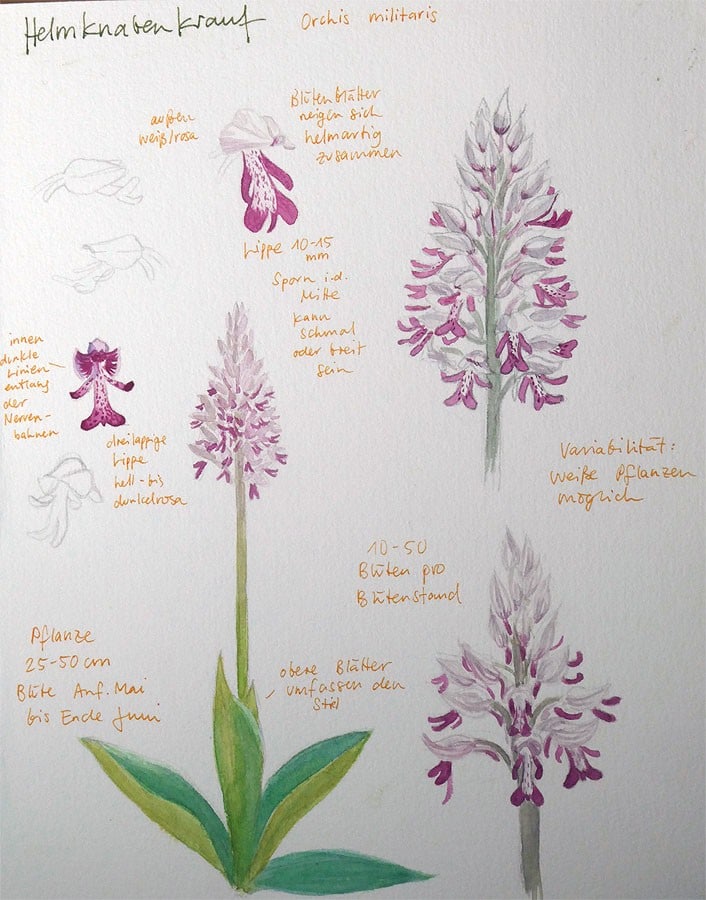
The German gentian (Gentianella germanica) is another rare plant that can be found in special habitats (here it grows on dry calcareous meadows and in alpine areas). Despite the name it can be found across Europe. I love the intense violet color of the flower – Cobalt violet is a perfect match for it.
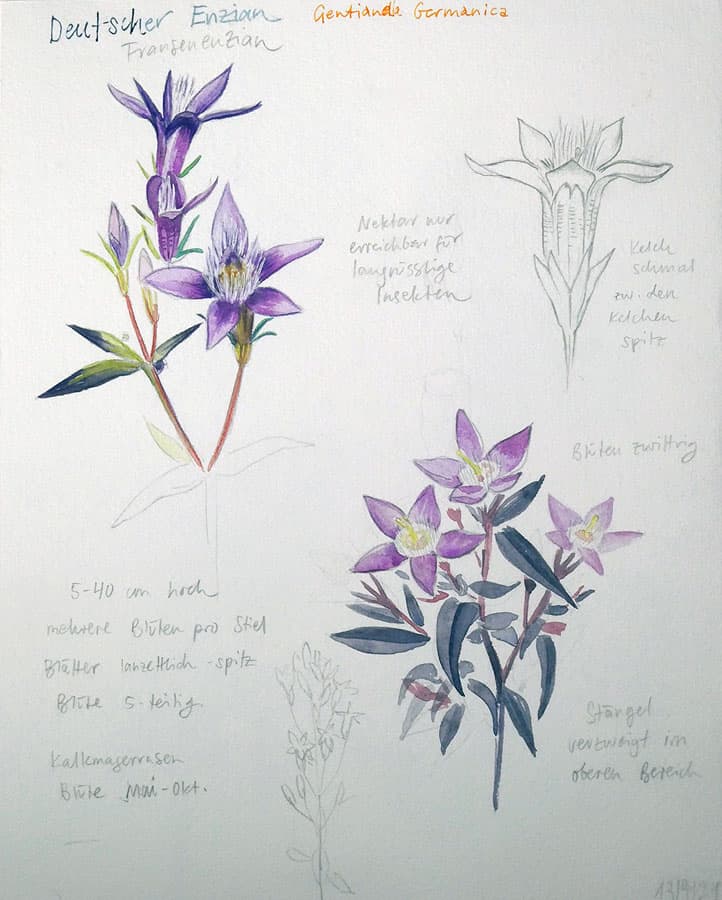
One of the most common herbs in these meadows is wild oregano (Origanum vulgare), also called Dost in German. It’s a favorite butterfly plant, and often grows in large cushion-like patches. I went for a slightly more informal landscape sketch here to see what a habitat illustration could look like. When I’m not in a protected area, I like to take a few flowerheads of this herb with me back home – it’s great for tea and on pizza and pasta.
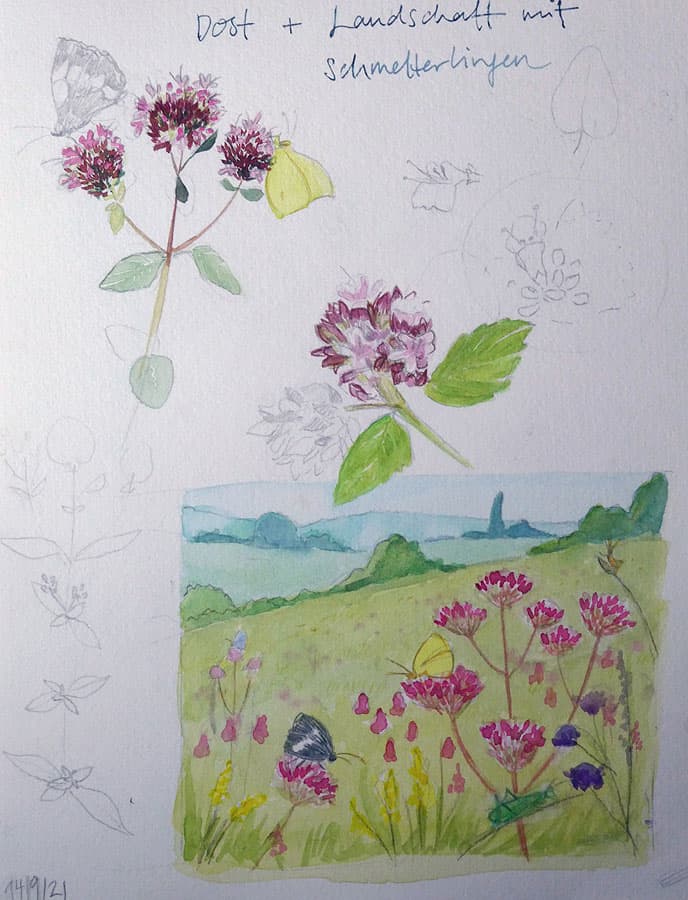
I will continue this sketchbook tour with a second part – I did so many of these detailed studies that it would overload one post. Hope you enjoyed these outtakes so far!


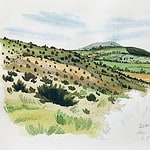
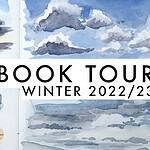

This is so neat……what a fun project you are working on…….beautiful illustrations and great explanations. Thanks
Thank you Janey! It is definitely a lot of fun to do this. 🙂
Hi Julia, these pages are so pretty. A very informative talk about the details of these plants and animals. Thank you.
Thank you very much Sandra!
I enjoyed your knowledge about wild orchids in particular. I’ve only spotted a couple of Lady Slippers in my lifetime. Lovely artwork with lots of detail.
Thank you DeeAnn! From what I’ve read and seen, Lady Slippers are indeed very rare, and many protected sites don’t even advertise them because apparently there are people who dig them out!
Very beautiful drawings! I’ve always wondered: how are you able to sketch birds? I can never get a good enough look before they fly away! Do you rely on photo references as well as observation?
Thank you Lynn! It’s a mixture of practice, being very patient, and taking photos.
Hello, I look forward to your blog posts and sketchbook tours. These are lovely pages! The newts and the orchids are so well done. I especially like the way you left parts of one orchid drawing without color. What is your medium here? Is it both gouache and watercolor? also, colored pencil or watercolor pencil maybe? Thanks for sharing your work and techniques.
Thank you Tracie! I mainly use watercolor and a bit of colored pencil.